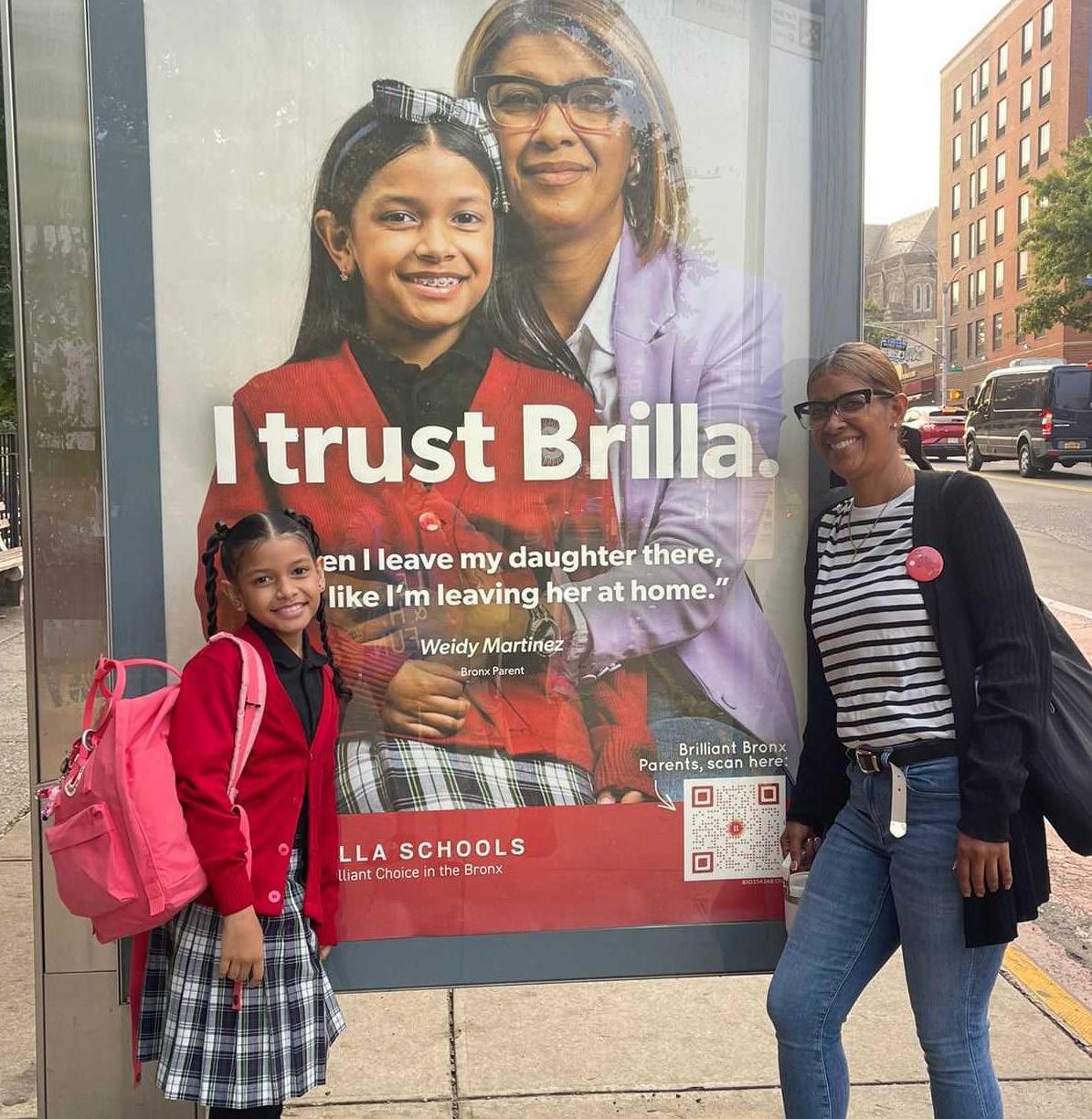What makes an education BRILLIANT?






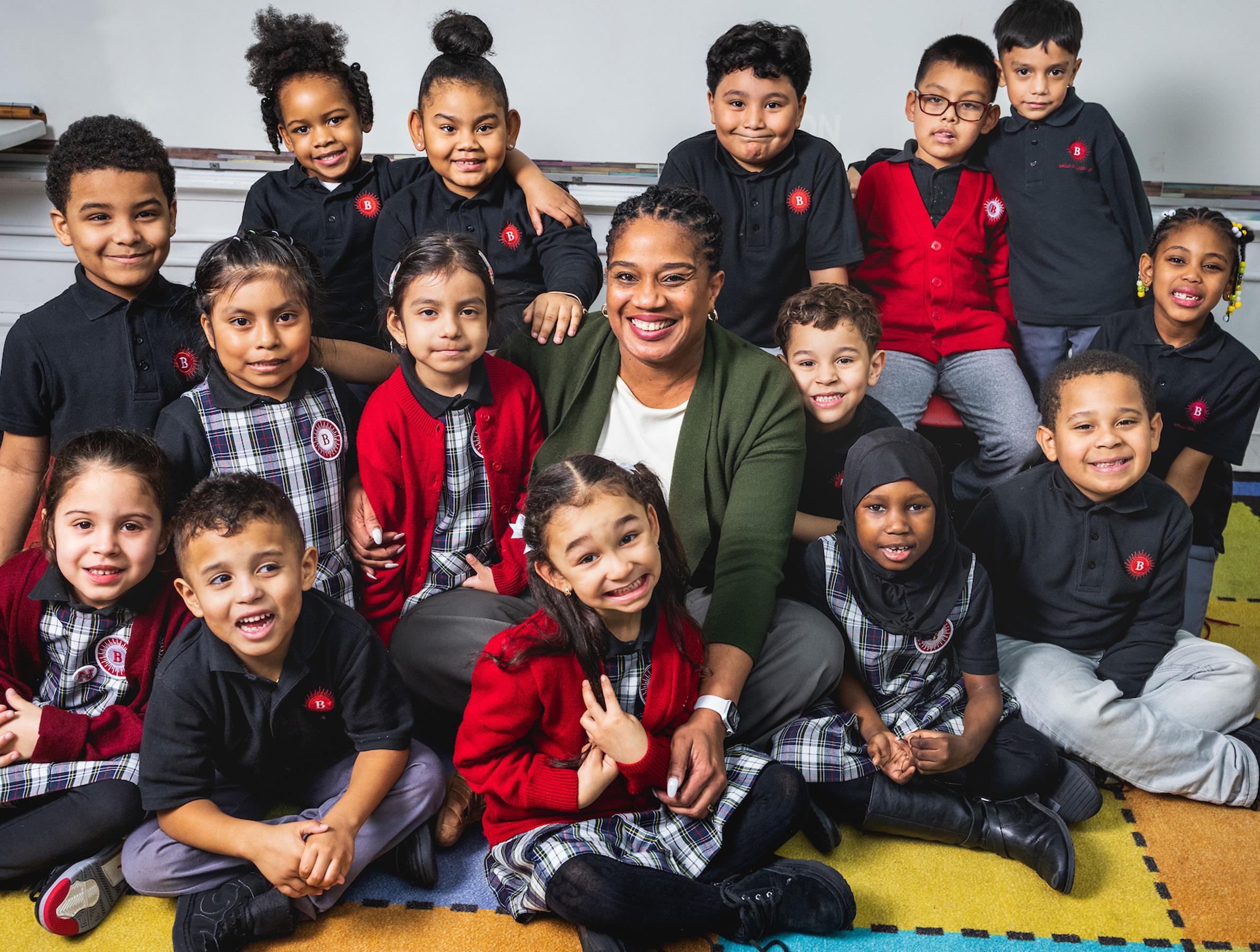
I know from my own experience that choosing the right school is one of the most important decisions you make as a parent.
Hello, I’m Yeime Valle, the Executive Director of Brilla Charter Schools. I am also an immigrant and a mother who raised six beautiful children in the Bronx.
For me, the biggest consideration in selecting a school was that my kids were going to feel safe, that my kids were going to be loved. I needed to feel good about the adults in front of them. That’s why I would always visit a school before I made my decision.
Academics are important, of course. You want to select a school where your child’s mind is going to light up.
But for me, the most telling clues come from listening to your intuition. How you feel when you walk into the building? Do you feel welcome? Are people polite? Does this feel like a place where your child is going to be well cared for, safe, calm?
I was part of the group that founded Brilla some 10 years ago. Our desire then is the same as now: not to become
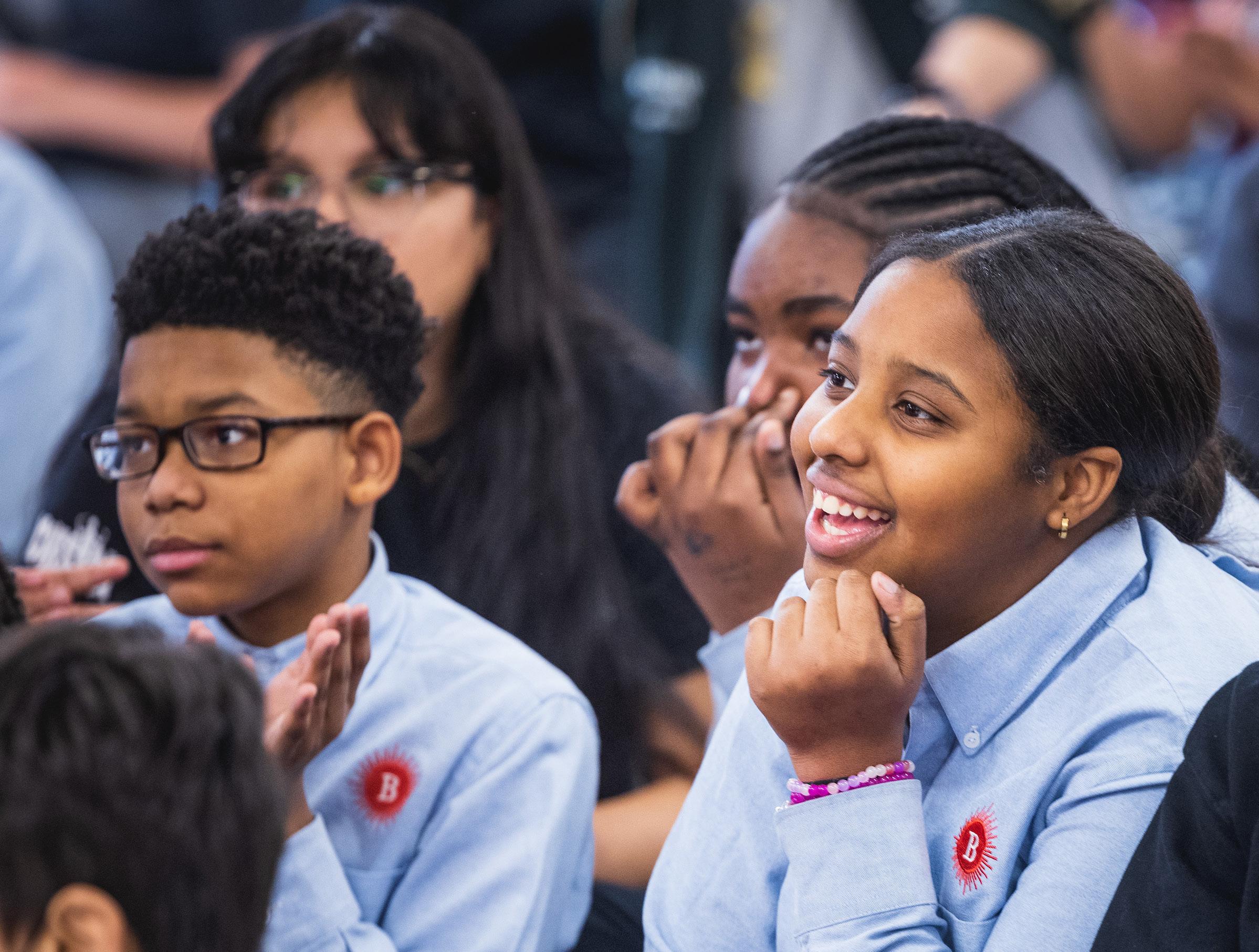
What makes an education
some national chain but to focus all our energy on our home, the Bronx. I have stayed at Brilla because we do what we say we do. We work really hard to deliver the type of school some parents can only dream about.
Brilla is a school where children fall in love with learning about the world and about themselves—a place where they are excited every day to go to school.
But don’t believe me. See for yourself the way our incredible teachers engage our young scholars. Listen to the way their heart pours out when they talk about their work. Experience the warm and inviting culture that every day inspires happy, achieving, confident children. If this sounds too good to be true, then schedule a visit and you will discover something amazing. It is true.

Yeime Valle Executive Director, Brilla Public Charter Schools Mother of Six
Brilla is the only school in the Bronx that recognizes parents as the first educators.
That means our teachers treat parents and families as partners in their child’s education. You are welcome to visit our classrooms, attend student activities, and to be part of your child’s educational process.
At Brilla, your child’s teachers are in constant communication with you about your child’s progress and any challenges they may face. We know that each child learns differently and we have extensive in-house resources, such as speech therapists and student counselors, to provide extra support for students and families when needed.
We also teach your child what it means to be a good person—with a separate program that cultivates character traits such as courage and kindness. Plus, we offer lowcost afterschool through our exclusive partnership with El Camino. Our students say Brilla feels like a second home where they feel seen and heard and respected.
Result? 85% of our Kindergartners are proficient in math and English. Our 8th graders get into the best high schools
in New York—and earn millions of dollars in scholarships. And 98% of our parents surveyed say that Brilla was the right choice for their family.
We know there are many good schools in our neighborhood but there’s only one that includes parents, teaches character, and gets outstanding academic results.
There’s only one Brilla.

At Brilla, we know that family involvement in your child’s education is the key to success.
Everyone at Brilla believes that the parent is the first educator. That’s why we partner with parents and families at every grade level. Research shows that students whose parents stay involved in school have better attendance and behavior, get better grades, demonstrate better social skills, and adapt better to school.
Family involvement also helps students to develop a lifelong love of learning, which is a key to long-term success. At Brilla, you are invited to attend classes to see your child in action. We keep you up to date on your child’s triumphs and challenges. It’s important that we are always on the same page, so that families can support the educational process through reading, discussion, and homework at home. And you can always call your child’s teacher to speak about any questions or concerns you may have.
Constant Communication—In addition to regular texts, emails and calls from your child’s teachers, each campus has one school-wide bulletin board (typically near the entrance and easily viewable by families at drop-off and pick-up) which contains relevant and timely content. We also post highlights on social media and publish a bilingual monthly school-wide newsletter.
Weekly Roosting Rallies—This is our weekly spirit event for scholars, and families are encouraged to attend! It’s a time every week to see the children excited about being in school, chant for their homerooms, talk about virtues, and applaud the Scholars of the Week.
Monthly Coffee and Conversations—Each month, parents, principal, teachers, and staff get together for coffee and conversation, an opportunity in a relaxed, informal atmosphere, to discuss your child’s education or any aspects of the school culture and educational process.
Parent University (3x a year)—Parent Univeristy allows families to directly engage in content related to their child’s development and other relevant concerns or questions. Topics and best practices highlighted include curriculum, character and virtues, anti-bullying, how to have crucial conversations with children, boundary setting, and more.
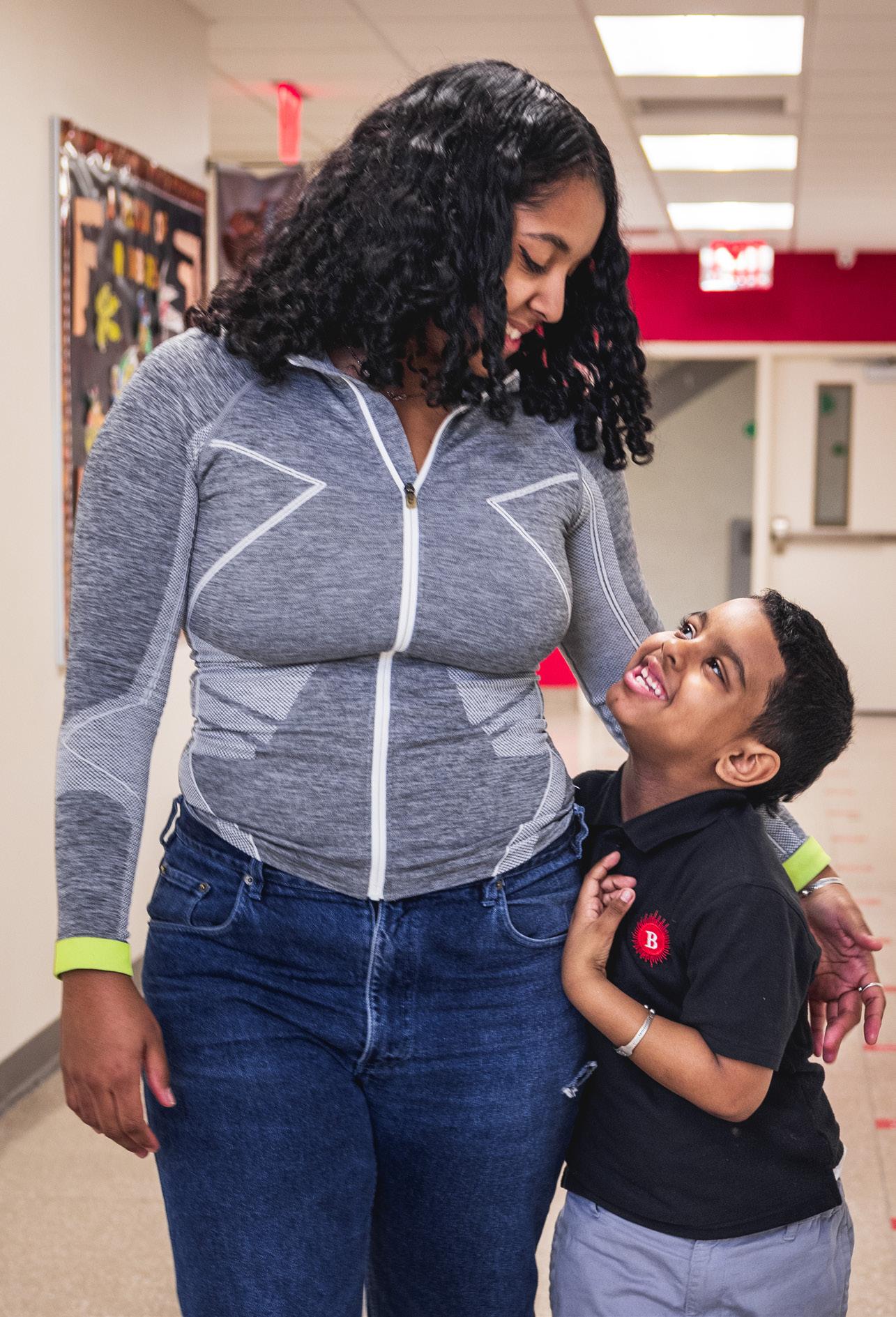
Parent and Family Events
Report Card Conferences (2x a year)
Monthly FIC Meetings (Family Involvement Committee)
Back To School Night (a presentation of what to expect in the coming year)
Brilla Schools Community Celebration
Fall Festival (Costume Carnival)
Thanksgiving Food Drive
Holiday Door Decorating Contest
Middle School Toy Drive
Spell-a-Bration
Spirit Week
Winter Olympics (full day of games/no classes)
Lucky Day
Eggstravaganza
Admissions Celebration Event (new families)
State Exam Celebration Dance
Formal Dance (Cotillion)
8th Grade Prom
Home Visits (new families)
8th Grade Graduation
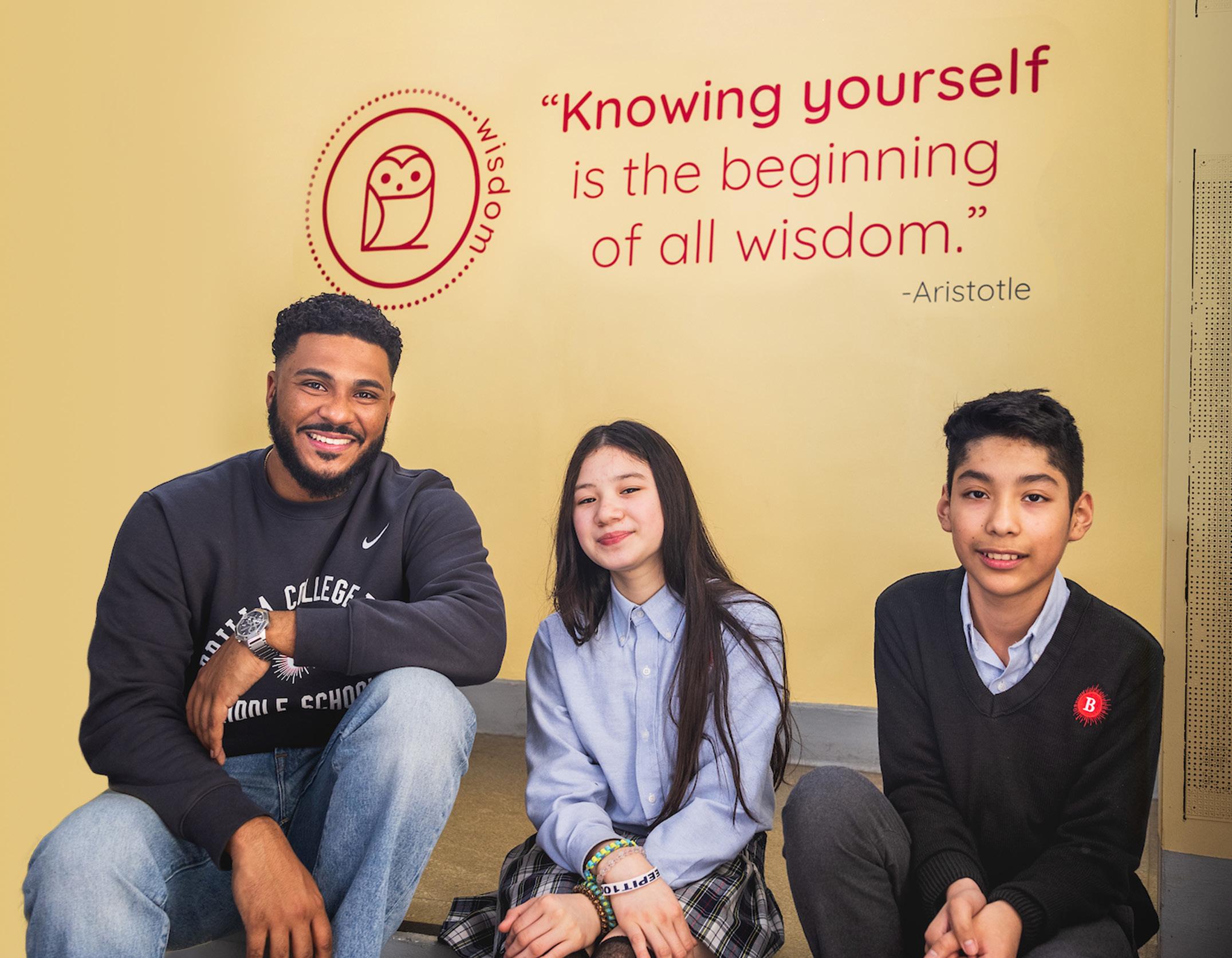
We all want our children to be honest and caring and courageous. We want them to respect others who may be different. We want them to become responsible adults capable of making good decisions in their lives. We want them to care about their families, communities, and themselves. And we want them to prosper in whatever career they choose.
As any parent knows, these things do not just happen automatically. Children learn how to act by observing the example of influential adults, by reflecting on their own personal experiences, and through direct instruction. That’s why character education at Brilla is not a one-class-a-week elective. It is at the heart of everything we do.
Beginning in Kindergarten, teachers in every subject area use stories and discussions to explore virtues and encourage students to reflect on their actions and decisions.
We also include families in every aspect of character approach. For example, we make sure on bulletin boards and in emails that parents know the Virtue of the Week so they can explore its importance at home.
We have designed our school schedule with many opportunities to learn about virtue and good character traits: Bird Call, Morning
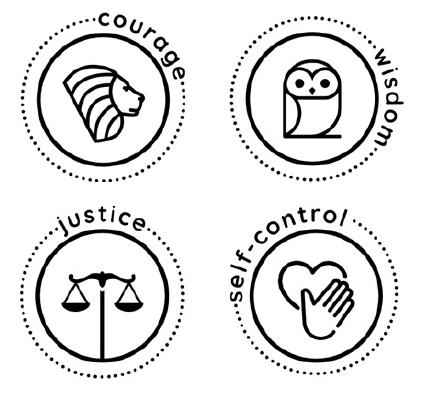
Our core virtues are based on the four cardinal virtues of classical antiquity. We agree with Aristotle that possessing these virtues forms the foundation for a good and happy life, and a flourishing career. Each week, every student from K-8 is instructed on a virtue. At the end of the week, the entire school comes together and celebrates classmates who have exemplified that week’s virtue at our weekly Roosting Rallies.
Meeting, Recess, daily classes in Character Studies and Social-Emotional Learning, Community Circle, Celebrations, and the wildly-popular weekly Roosting Rallies.
At the end of each school day, our students participate in a beloved Brilla tradition that we call “The Quietest Moment of the Day”—a 2-5 minute guided reflection that consists of an intentional set of movements.
1. Calm Self—Allows scholars and staff to center mind and body, ideally resulting in a silent, if not quiet, classroom where all participants can focus on self.
2. Gratitude—Encourages scholars and staff to consider individuals, moments, or opportunities they are grateful for.
3. Daily Review—A moment to replay the day and consider the moments that are most important.
4. Personal Assessment—Centered around virtue, scholars are asked pointed questions about the way they and their peers have practiced being their best selves.
5. Look Forward—Thinking of the time coming ahead, scholars make a commitment to be their best for the rest of the day.
CORE VIRTUES
Wisdom
Courage
Justice
Self-Control
SUB-VIRTUES
Empathy
Gratitude
Heroism
Honesty
Humility Initiative Integrity
Kindness Mercy
Moderation Responsibility Patience
Perseverance Respect Diligence
Orderliness
Modesty
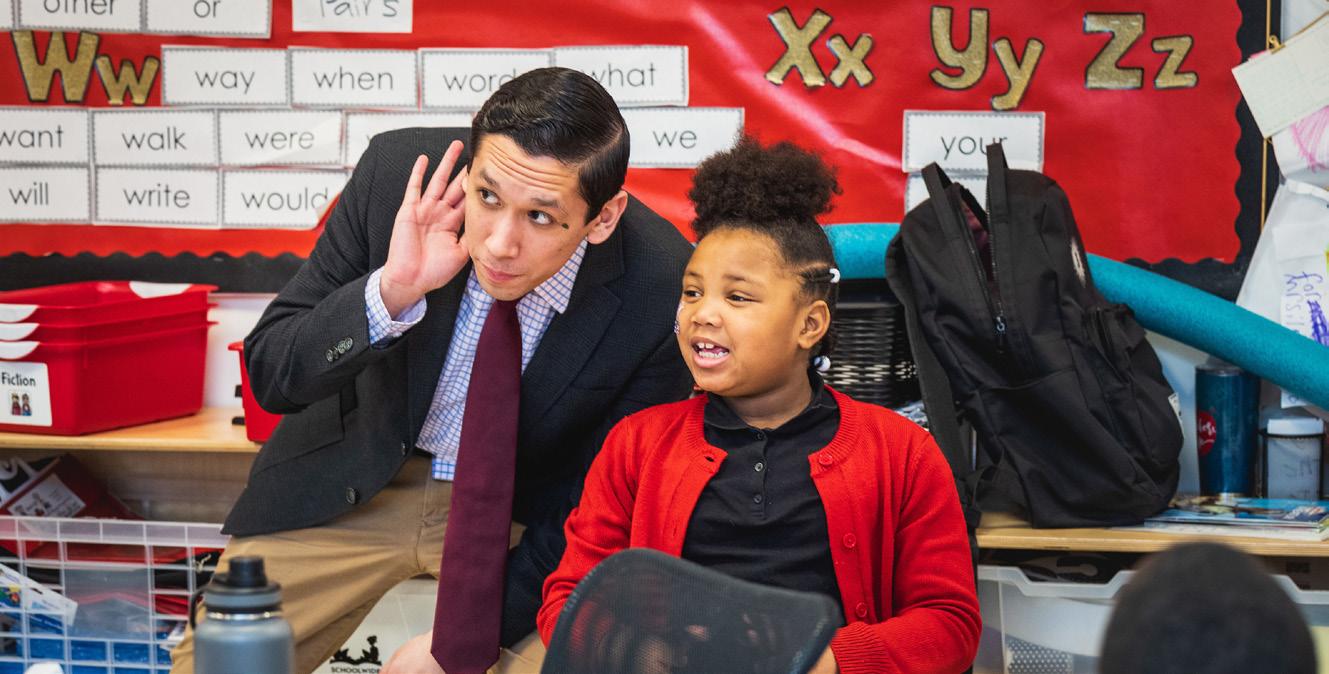

The Brilla curriculum is classicallyinspired, which means we teach the best ideas of western civilization. But unlike many other schools, we’re always doing this in a way that is culturally complex. We are always looking for ways those ideas show up in other cultures, at other times, in other places. For example, we know that exploration has been good for humanity and it has also been detrimental for humanity. So, we ask: What are examples where it’s been good for humanity? What are examples where it’s been detrimental for humanity? The answers are complicated, and that is how we learn.
The building blocks of a Brilla education include:
English and Language Arts (ELA)
Math
Reading and phonics
Writing
Science
Humanities
History
Character
Fine and Applied Arts
The Brilla formula works. Our students significantly outperform their district peers in New York State Assessments for ELA and Math.
Here are a few features of the Brilla approach to education:
Blended Learning and Technology: Every classroom has 15 laptop computers which allow teachers to work with smaller groups. The digital
programs are adaptive and provide targeted lessons for each student’s particular level.
Field trips: Brilla takes advantage of its location in one of the world’s greatest cities by taking learning outside the classroom. Each grade goes on regular field trips. Parents and families are always welcome to come along.
Middle School: At Brilla, the goal of Middle School is to prepare each and every scholar for advanced work that will get them into the best high schools in NYC. We have a proven track record of accomplishing this goal. In Middle School, learning is student-driven and teacher supported. We do not want our students to passively receive information, but rather to discover the information for themselves. We know that learners deepen their understanding of a topic through social interaction, dialogue, negotiation of ideas, and other collaborative activities. And this allows the teachers to monitor each student’s progress rather than focus on lecturing.
Following are some themes and highlights scholars will experience as they learn and grow grade-by-grade.
Kindergarten serves as the cornerstone for elementary school education, laying the essential groundwork for academic development and healthy social engagement. Themes feature our community, nursery rhymes, folk tales,
kings and queens, seasons and the weather, farms, earth, and early American history. During the unit on farms, the class raises baby chicks. In writing, scholars learn to use pictures and letters to represent ideas and words. They learn to count and grasp the concepts of the base-ten number system. They also delve into the exploration of flat and solid shapes, describing and classifying them based on their attributes and understanding their spatial relationships. The introduction of Socratic seminarstyle discussions tailored for young learners encourages thoughtful questioning and sharing, fostering a classroom culture of mutual respect and curiosity which continues in every grade throughout their Brilla education.
First Grade themes feature fables, early civilizations, human body, animals and habitats, frontier explorers, early civilizations, and stories from around the world. Scholars learn to focus their writing on a topic or idea and expand on that. There is an emphasis on writing in sentences and grouping multiple sentences together to form a paragraph. Scholars advance their mathematical skills by delving into more complex concepts related to numbers and operations and continue to build their understanding of place value. Scholars also engage in composing and decomposing geometric shapes and transition from concrete models to pictorial and abstract models, showcasing their evolving problemsolving methods.
In Second Grade, themes include mythology (students create own myth stories), immigration with a visit to Ellis Island (they re-enact the immigration process and compare it to modern-day), the Civil War, cycles in nature, dignity, fairy tales and tall tales. In Second Grade, scholars learn to write multiple paragraphs about a given topic. There is a focus on organization and rereading for precision with language and conventions. Scholars explore different forms of writing like graphic novels and biographies. Second Grade is the bridge between early foundational number concepts and the more sophisticated work of the upper elementary grades. Students learn more sophisticated addition and subtraction strategies. Second graders enhance their proficiency in reading, writing, and comprehending the magnitude of three-digit numbers.
A big change in Third Grade is that scholars now have different teachers for different subject areas. A favorite focus in Third Grade is Vikings (students make Viking ships). Features include more ancient civilizations, exploration, Ancient Rome, ecology, classification of animals, as well as science every day. Scholars continue to practice organizing their writing as they publish multiple research assignments. The third grade develops their understanding of the relationship between operations and number concepts. Third graders learn about fractions by identifying, comparing, and reasoning about them. Science class begins exploration of balancing forces, inheritance and traits, and environments and survival.
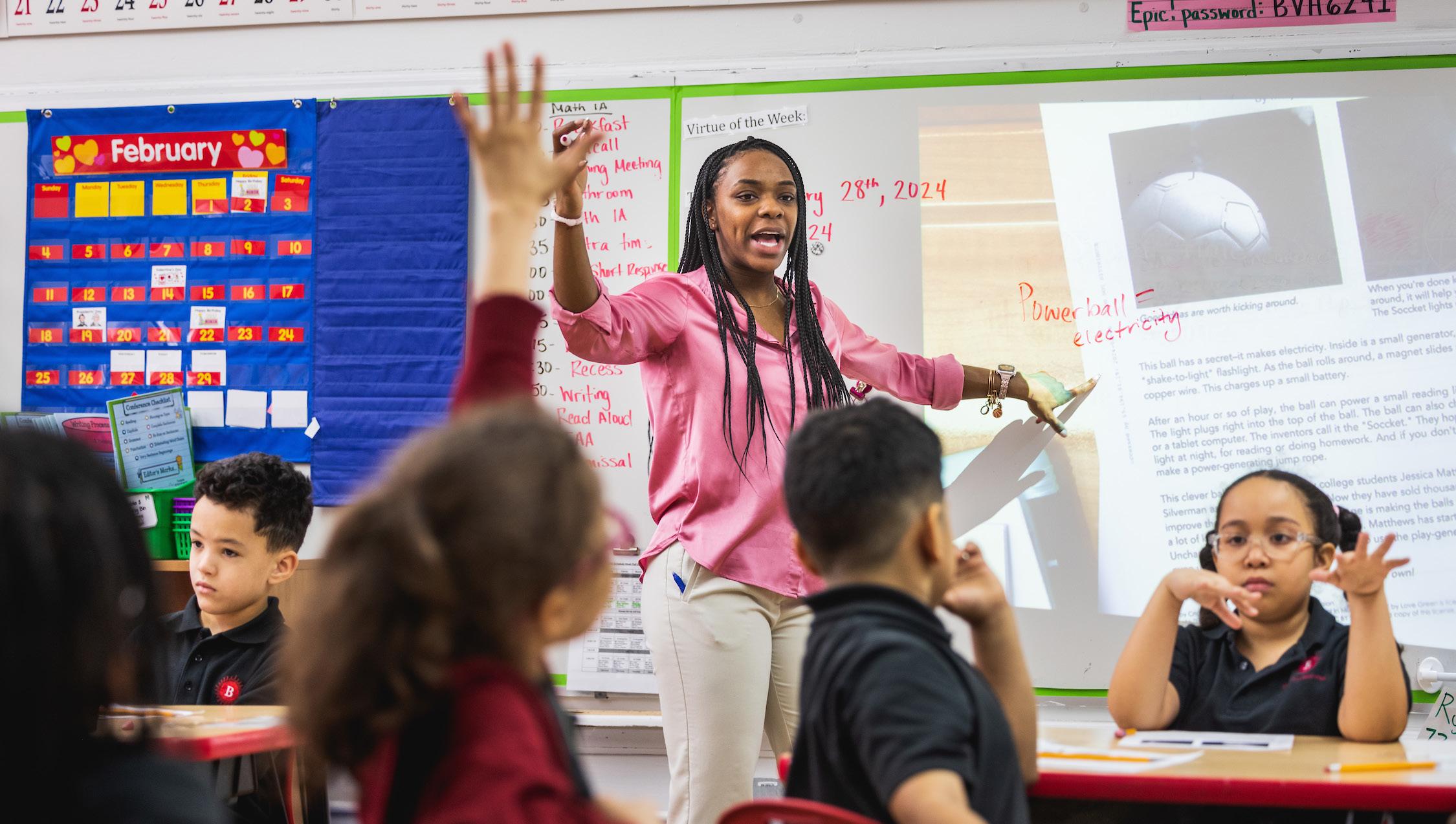
In Fourth Grade scholars read a lot of classic books including Robin Hood, Cricket in Time Square, and Treasure Island. They study the American Revolution, visit Philadelphia, and write every day. To improve their speaking and written skills, scholars participate in increasingly sophisticated discussions grounded in topics like the rise of the Islamic Empire, the American Revolution and Geology. And in Fourth Grade, scholars produce multiple historical fiction narratives, informational essays and opinion texts grounded in response to literature and research. Scholars are now applying operations and number concepts to real world problems. They delve into the place value of multidigit whole numbers and build on their understanding of fractions.
The Middle School journey to advancedlevel work begins in Fifth Grade. English builds knowledge of key topics in history, science, and literature through the study of excellent texts. By reading and responding to stories and nonfiction texts, scholars build knowledge by asking what it means to belong to a culture.
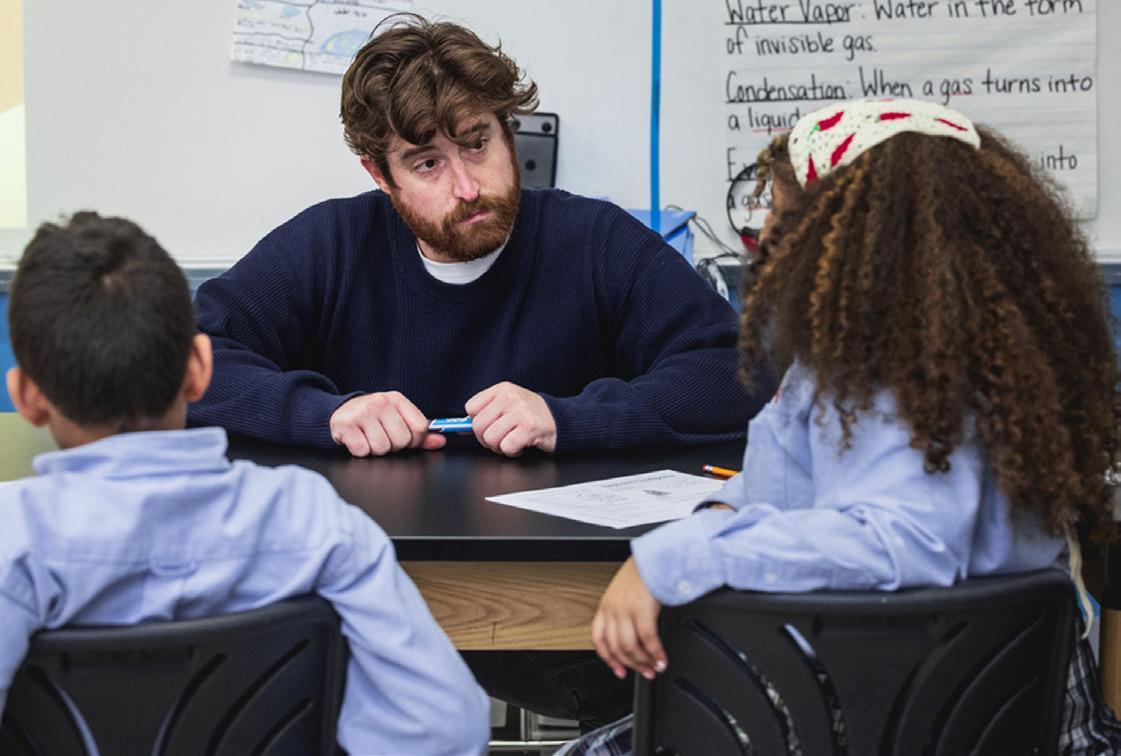
We study the way we use words to define and organize our world. Scholars learn
about the many ways in which war affects people and its many consequences. And students are exposed to the power that sports have to affect how people view each other. In Math, the big ideas include developing fluency with fractions, extending division to two-digit divisors, developing understanding of operations with decimals to hundredths, developing fluency with whole number and decimal operations, and developing understanding of volume. In Science we highlight real-world contexts and encourage students to investigate, talk, read, write, think, and argue like real scientists and engineers, with hands-on materials, scientific texts, robust digital simulations, engaging media, physical and digital models, and much more.
The high school readiness process begins in Sixth Grade as individual scholars begin high school visits and explore various options with Brilla’s high school placement counselors. In Sixth Grade English, we study one of the worst economic events in United States history, the Great Depression, exploring the hardships families faced as well as their triumphs. We also study what makes a hero. Is it simply courage, or something more? Students work across multiple texts and genres to construct a complex picture of life and struggle in Jamestown, and we explore what it means to endure hostile environments and respond heroically to positively impact others. In Math, sixth graders begin an accelerated “double dose” program in math so that they will be prepared to take Algebra
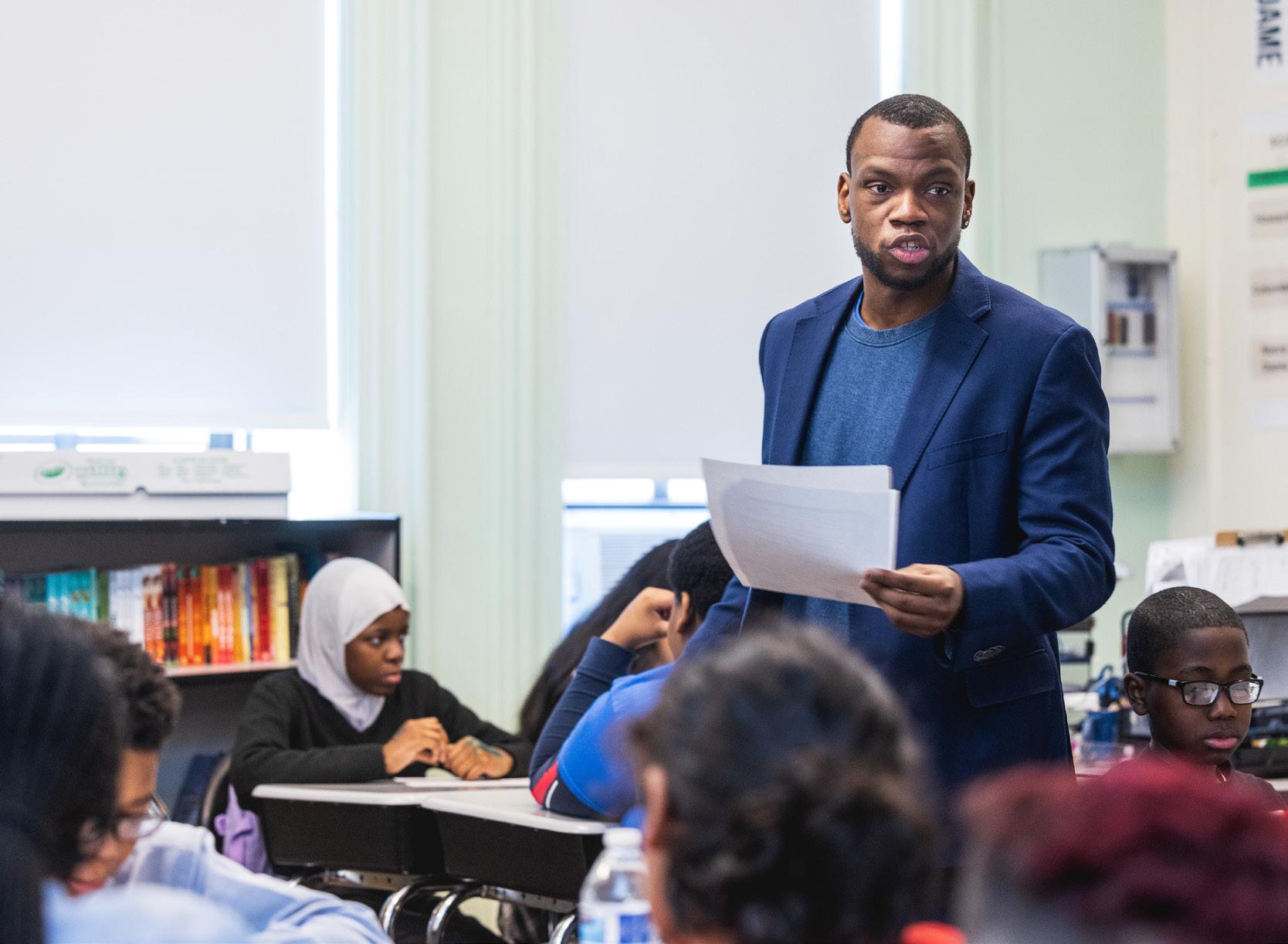
in eighth grade. The course begins with a study of area and surface area concepts. Next, students begin study of ratios, rates, and percentages, followed by looking at percentage concepts and applications such as sales tax, tipping, and markup. In Humanities scholars learn about Greek philosophers such as Socrates, Plato, and Aristotle, and many aspects of Roman history. And in science we explore the earth, moon, and sun, geology on Mars, rock transformations and plate motions, ocean atmosphere, weather patterns, and the earth’s changing climate.
Seventh Grade English places a heavy emphasis on vocabulary and grammar knowledge. Students participate in weekly vocabulary assessments as we read and analyze three whole-class novels over the course of the school year. Students are taught to think critically about these texts and develop test-taking skills in preparation for the New York State Exam. The accelerated program in math continues with students studying scale drawings, an engaging geometric topic that supports the subsequent work on proportional relationships. Students move on to operations with rational numbers, both positive and negative which leads to the work on expressions, equations, and inequalities in the next unit. Students
then put their arithmetical and algebraic skills to work on angles, triangles, and prisms, and on probability and sampling. In Humanities, we study the two world wars, the Russian Revolution, and America from the 1920s to the New Deal. Scholars study of Physical Science serves as an introduction to physics. The focus is to apply science in real-life scenarios and to prepare them for high school readiness and beyond.
All scholars in Eighth Grade take the NYS Regents Examinations for Algebra I and Living Environment and will soon also take World History I. In English, Brilla scholars work on refining their reading and writing skills with increasingly challenging texts. We read and write compelling poetry using figurative language, create persuasive arguments, and analyze authors’ specific word choice in a non-fiction context. We study and act out a Shakespearean play in class. In Algebra, scholars begin the course with one-variable statistics, building on ideas from middle school. Gathering and displaying data, measuring data distribution, and interpreting statistical results encourages students to collaborate, communicate, and explore new tools and routines. The course ends with a close look at quadratic equations. Humanities focuses on American History, primarily on the Founding Era, Reconstitution, The Cold War, and The Civil Rights Era. We engage with primary sources from these eras, and students create and defend claims about these sources. And in Science we explore ecology, cells, an introduction to genetics, evolution and the diversity of life.
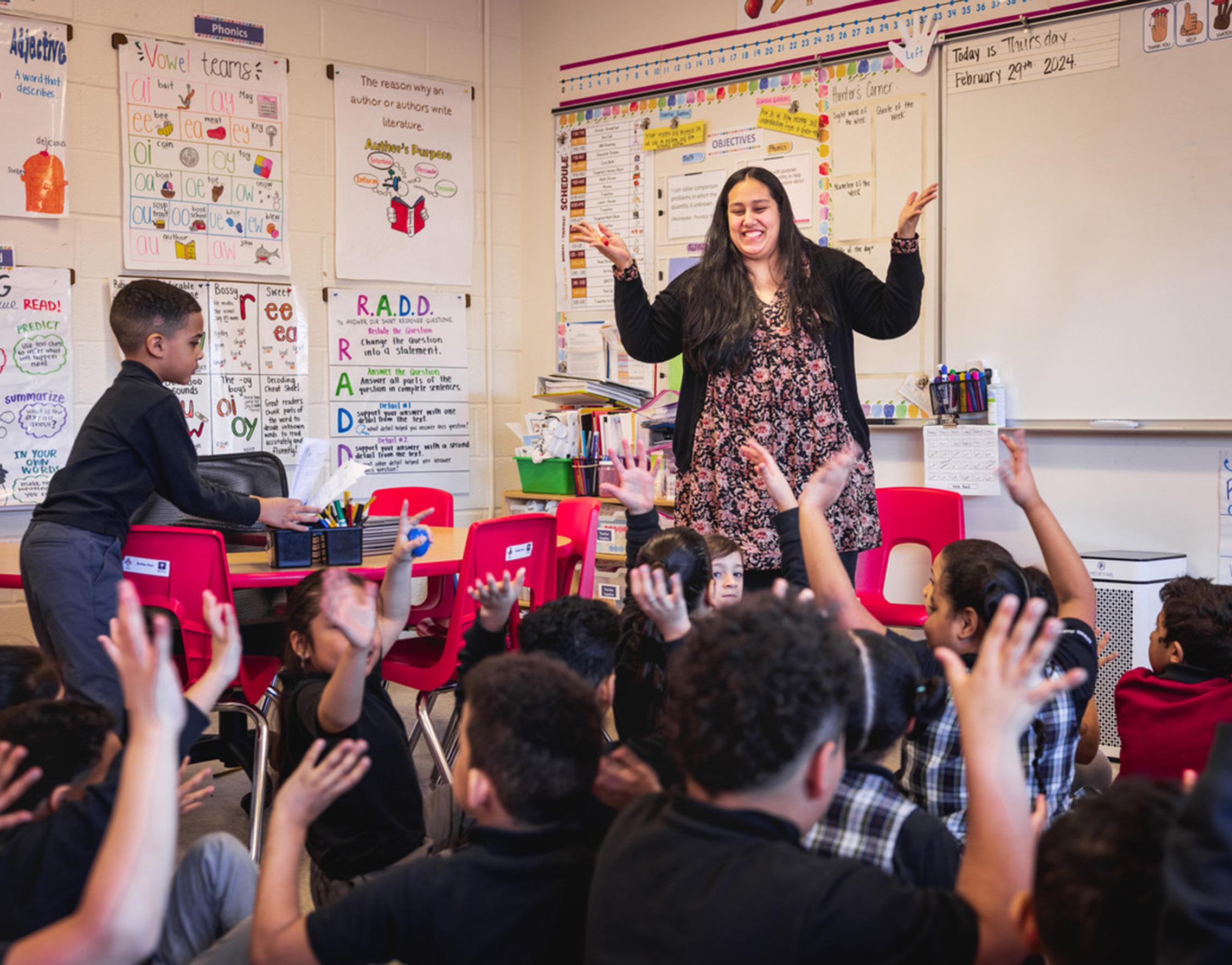


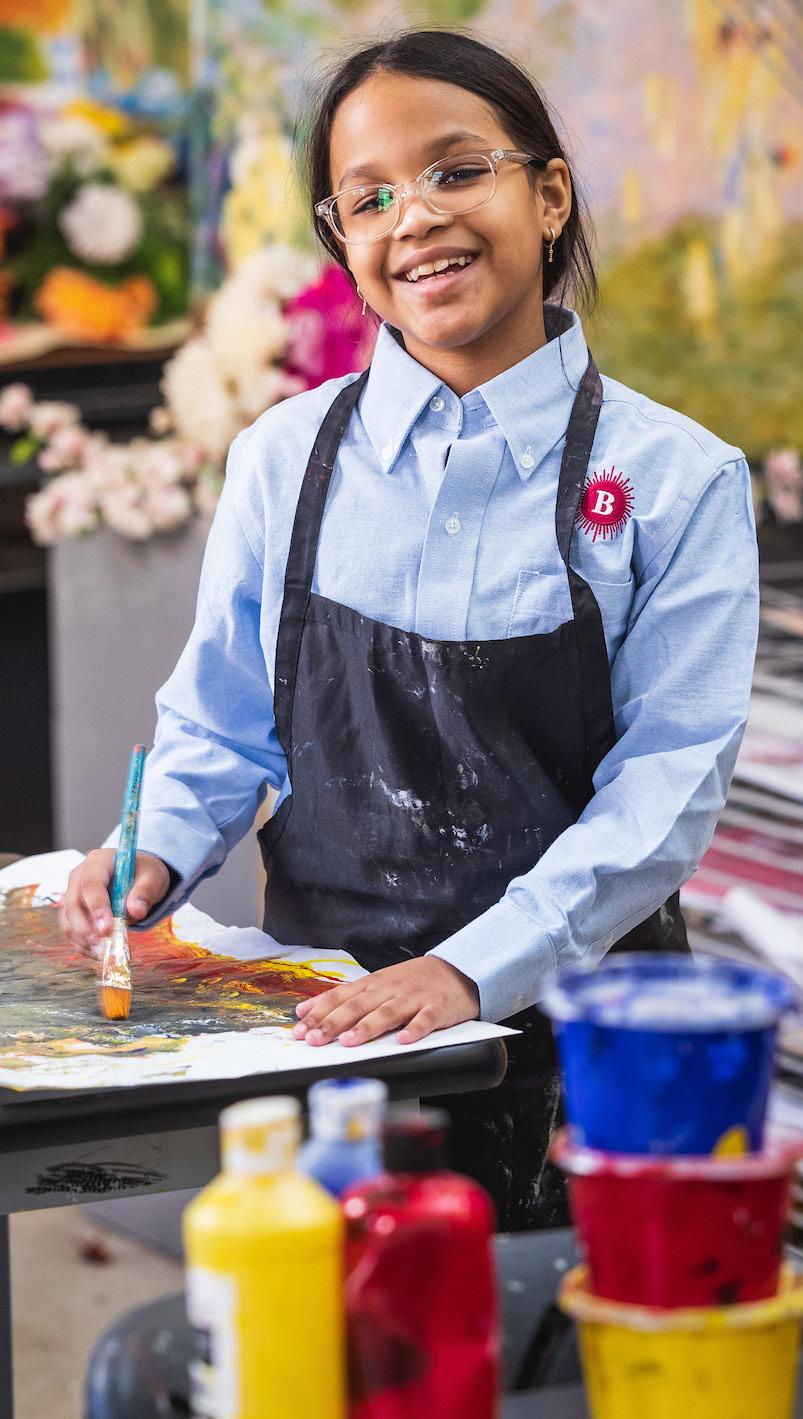
Throughout history, art has been used to tell stories, explore cultures, and express our identity, beliefs, and thoughts. The arts connect us to our mind, body, and spirit and open a lens to learning at a deeper level.
We believe that it’s critical to form a strong artistic foundation in elementary school. Students who are highlyengaged in the arts are twice as likely to graduate college as their peers with no arts education. Studies show students who take four years of arts and music classes average almost 100 points better on their SAT scores than students who take only one-half year or less. Children who participate in the arts also demonstrate greater social and emotional skills.
That’s why the Fine and Applied Arts (FAA) program is central to a Brilla education. While most schools treat arts as a side dish, the arts at Brilla are part of the main course. Students at Brilla attend FAA classes every day in every grade from Kindergarten to 8th grade.
The FAA program introduces students to beautiful works and forms.
Students learn about the history and impact an artist’s work can have on our world.
Students who are highly-engaged in the arts are twice as likely to graduate college as their peers with no arts education.
The elementary curriculum teaches students the foundational artistic techniques and skills by studying and emulating historical masters. In the middle school years, students apply these techniques and skills to individual and collaborative projects, continuing
to hone their craft and tune their eyes and ears to beauty. We place student mastery and student work front and center.
The collaborative nature of the arts encourages children to work with others, builds their communication skills, and teaches them how to work through conflicts. Studies have shown that the arts help reduce stress and anxiety, lower levels of aggression, and improve overall mental health and selfesteem.
The FAA program also includes a physical education program that empowers students to adopt lifelong activity and wellness practices. Fitness activities focus on the five components of health-related fitness: aerobic capacity, muscular strength, muscular endurance, flexibility, and body composition. Scholars learn the specific skills —including sportsmanship and character—needed for a variety of sports.
At Brilla, we are committed to providing extra support to students with learning challenges or disabilities—so that they can learn in school like everyone else.
All scholars at Brilla receive intervention and enrichment services through targeted small-group classes in literacy and math.
We also have a full-service Special Education team that includes in-house professionals. Special Education includes services, programs, and specially-designed instruction to meet the individual needs of a student with a disability.
The main components of special education include: 1) evaluating and qualifying students with disabilities, 2) designing the Individualized Education Plan (IEP), and 3) implementing the program.
Led by an Assistant Principal for Student Services, every one of our campuses includes a full-time social worker and speech therapist. This allows parents to get to build relationships and trust the team that is educating their child.
We send regular progress reports for your child based upon the goals determined in the IEP so that you understand the goals, work on the goals at home and see how they are being measured.
We are proud to say that for multiple years we have achieved 100% compliance for providing every student with designated services.
We provide all qualifying students with the following services:
Multi-Lingual Learning—Individualized instruction support for multilingual language learners identified as needing at-risk interventions.
Special Education Teacher Support Services—Students work on mastering IEP goals, in a small group with data-driven instruction. This allows students with disabilities to be able to successfully access the general education curriculum.
Integrated Co-Teaching—General Education and Special Education teachers co-teach a class of students, some with IEPs and some without.
Speech Therapy—Our in-house speech therapists help students with speech and language problems to speak more clearly.
Counseling Services—Our in-house school counselors work with students to improve social, emotional, and coping skills.
Occupational Therapy—Our therapists help students with fine-motor skills and executive functioning such as self-care, problem solving, and social skills.
Physical Therapy—Our therapists help students develop gross motor skill development, balance, and coordination in all school settings.
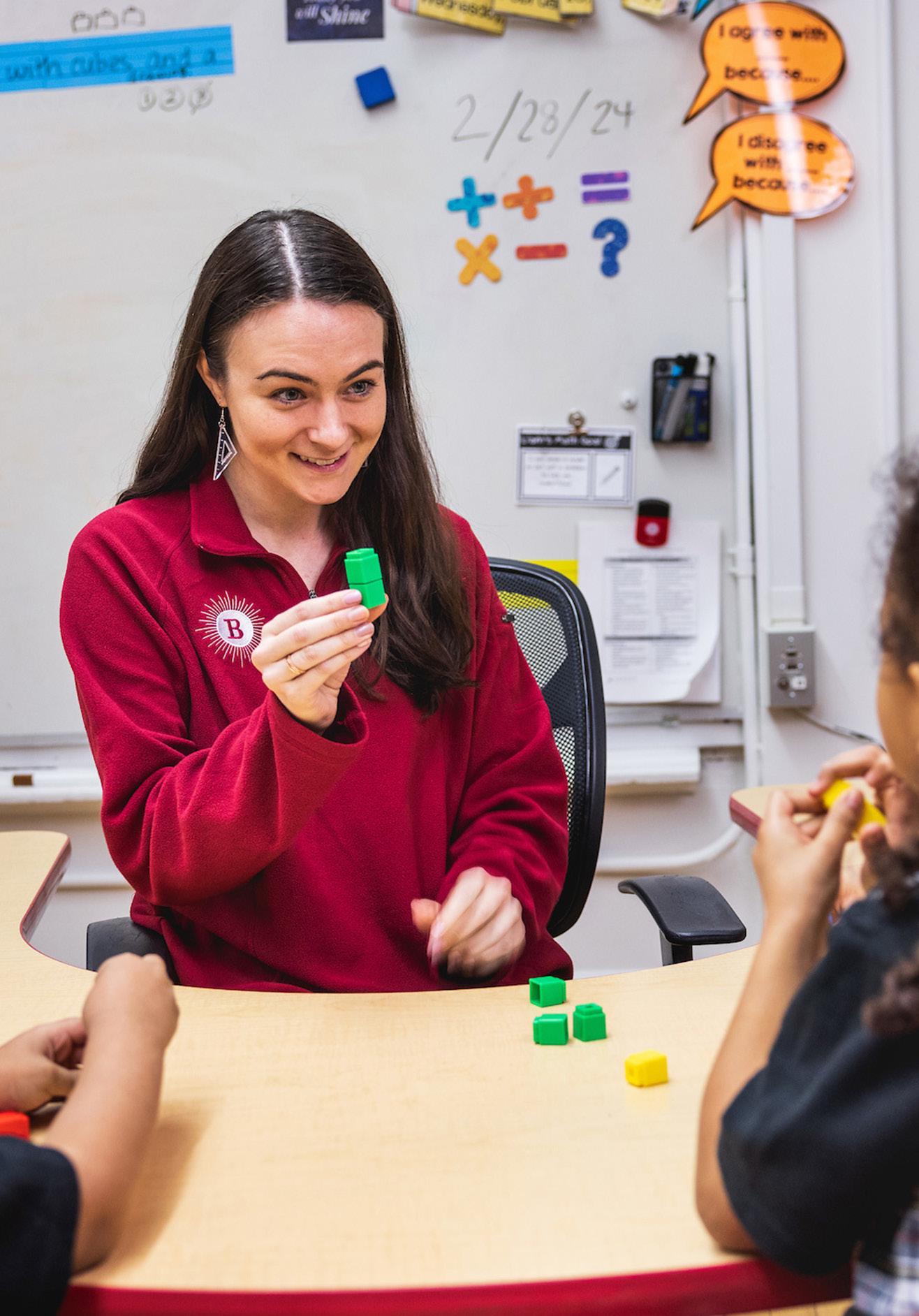
If you believe your child requires special education services, it is helpful to ask the right questions. Here are some questions you might want to ask your child’s teacher:
How do you support my child when they need help?
Do you have examples of my child’s work that we can look at together?
Is my child learning and developing at a rate that is expected for their age?
How does my child get along with other students in the classroom?
What are some learning activities I can do at home or in the neighborhood?
What are some questions I can ask my child when we read together?
How can I help my child if they are struggling with homework?
How did you choose Brilla?
I was very diligent and I visited a lot of schools. I wanted to make sure that my son, Ezekiel, would go to a school that would be a good fit for his personality.
And when I went to Brilla, the focus on character development was the biggest thing for me. Of course, I wanted to make sure that the school would be rigorous in academics, but also not forget about the whole child.
Why was character education so important?
We work a lot at home to make sure that he develops a good character, and so we wanted that to be extended in the school. I like how they actually give a grade on the report cards for character. Each morning, they make sure that the kids are learning about a virtues like empathy, self-control, and wisdom. It’s actually real.
How does Brilla treat parents?
To see a middle school staff that still wants involvement of the parents—that is a big, beautiful thing. Brilla makes sure that we feel part of the school, that we’re included in the decisions that they make. They’re really good at communicating. I know my son’s teacher. I know the principal. I see the principal every single day. He’s out there every morning and afternoon—even if it’s raining, he’s there. I can just go to
anybody and ask questions. And that has been consistent from kindergarten all the way until 6th grade.
What about the academics?
I think that the academics are great. My son has been able to keep on growing and his goals are pretty high. And when he hasn’t met the goal, he sees there is a learning curve and it’s okay.
Do you get involved at Brilla?
We have been able to help at the school whenever my schedule permits. I go to the Roosting Rallies. I like the themes. There’s a mixture of presentations like Scholar of the Week. Sometimes students do a presentation. So, we’re able to see a little bit of what’s happening in the classroom. It’s good energy. It’s fun.
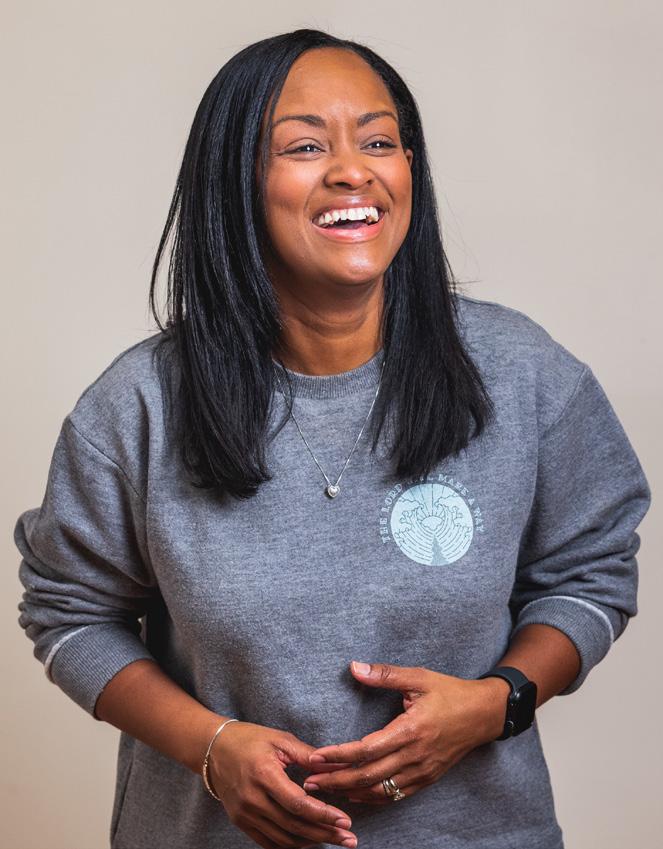
What other aspects of Brilla do you like?
I like that they partner with El Camino, the after-school program. I like having that choice.
Why have you stayed?
Brilla has grown and changed over the years, but unlike some other schools, the core has remained. I love that they continue to work with us, with families, and welcome families. They care about what families think. It’s been great for me. I would love more parents to know that.
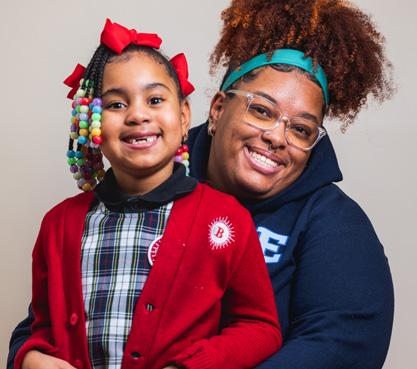


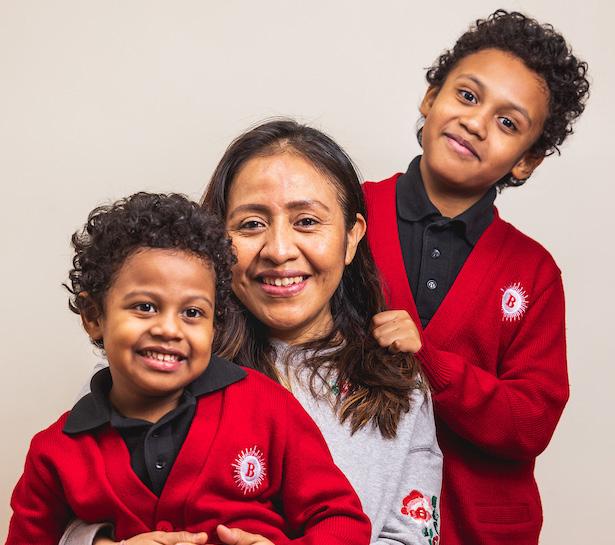
“I talk to the teachers every day. They text me. They call me. They let me know what’s going on. You can see the genuine love and happiness at the school. In the morning my daughter says ‘Mommy, you got to hurry up. I can’t be late.’ I just love how the kids love the school.”
“I was concerned because I don’t speak English, but whenever I need help, the school has always been there. The teachers have really good communication, whether it be via text message, phone call, or email. When I leave my daughter there, feel like I’m leaving her at home.”
“I like that they have the Parent Universities and that they do a lot of things that motivate the kids. When they do events, the kids get excited. They teach the characters traits. I feel parents have more opportunity to be inside the building than at other schools. ”
“What attracted to me to Brilla was the community, the relationship between teachers and parents. My two kids have an IEP, and the services that they provide for them are amazing. The patience the teachers have, the dedication… It’s wonderful.”
